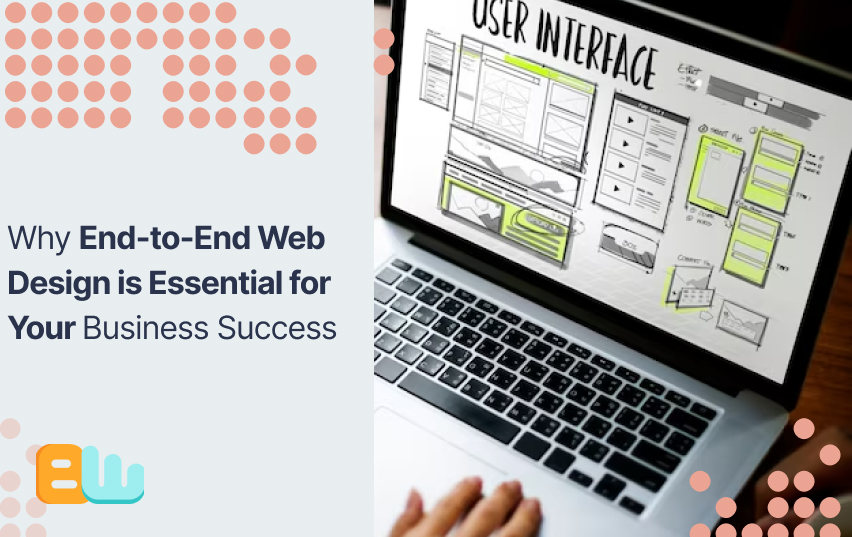
In our digital world, any business must have a solid online presence. Ensuring you have a great website is at the center of this kind of presence. A website isn’t just somewhere you show what you’re selling; it’s a powerful way to show off your brand, connect with the people you want to reach (your target audience) and get them to take action. This is where taking care of every part of web design from start to finish matters.
With an end-to-end approach in web design, everything about building your site—from its initial idea through launching it and keeping it updated—gets attention. This method ensures that each piece works well on its own and creates a fantastic experience for anyone visiting your site. It also helps more people find you via search engines like Google (search engine visibility) and keeps your brand image looking sharp.
In this blog post, we’ll discuss why paying attention from beginning to end when designing your website can play such a big role in your business’s success and what makes this process work so well.
Understanding End-to-End Web Design

End-to-end web design is about looking at the whole picture when making a website. It’s not just about how it looks but also includes things like how easy it is for people to use, how it gets found on search engines, how it works well on phones, and showing off what your brand is all about. This approach ensures every part of your site works smoothly to help your business succeed. When creating a website this way, there are several steps involved: planning out what you want the site to achieve in line with your business goals; designing it so that everything from colors to layout helps tell your brand’s story; building the actual site; checking everything works as expected without any glitches; and finally launching it for the world to see.
The Importance of a Holistic Approach
To build a solid online presence and meet your business goals, looking at web design from all angles is crucial. This means paying attention to everything that goes into making a website, like how it looks, how easy it is for people to use, and even technical stuff like how fast the pages load or if they work well on phones. By focusing on these details, you can ensure every part of your site fits together perfectly and makes visitors want to stick around and do something. This approach helps create not just any website but one that draws people in by offering them a great user experience while being pretty good-looking and easy to get around.
Critical Components of End-to-End Design
In the world of web design, there are a few essential parts you need to get right for your website to do well. First, picking the correct programming language is super important because it makes your site work smoothly and quickly. Then, there’s making web applications – those cool features on sites that let you interact with them more and make visiting more fun. And remember to design the user interface; this is all about ensuring your site looks good and is easy for people to use.
The Role of Web Design in Business Success
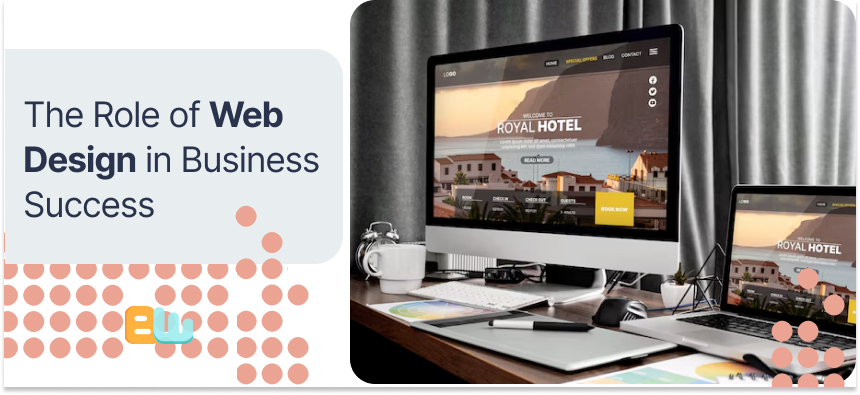
How your website looks is essential for your business’s success in the digital world. When someone first comes to your site, what they see can influence whether they stick around. A good-looking website makes a great first impression and encourages people to check out more of what you offer. It also plays a big part in digital marketing by drawing in and keeping the kind of visitors you want – your target audience. By putting money into professional web design, you’re setting up a site that grabs attention immediately but works hard behind the scenes to turn those visits into tangible results for reaching your business goals.
Creating a Strong First Impression
When someone first visits your website, it’s super important to grab their attention and make them trust you right away. Consider your website the initial handshake between your brand and people who might want to buy from you or work with you. You’ve got to make sure this first meeting is a good one. A website that looks great, feels like what your brand stands for, and shows how professional and trustworthy you are can do wonders. It should be easy on the eyes, simple to get around in, and filled with exciting stuff that keeps visitors moving forward on their journey with you.
Enhancing User Experience for Engagement
Ensure your website is easy and fun to use if you want people to stick around. It’s all about knowing what folks visiting your site are looking for and ensuring they find it without a hassle. If your site loads quickly, is simple to get around and has stuff that’s easy for the eyes to read, people will likely hang out longer. And when they enjoy their time on your site because everything just works smoothly, there’s a good chance they’ll want to buy what you’re selling or come back again. To pull them in, having buttons that catch their eye telling them what to do next or calming things that pop up here and there can also make a big difference.
Essential Elements of Effective Web Design
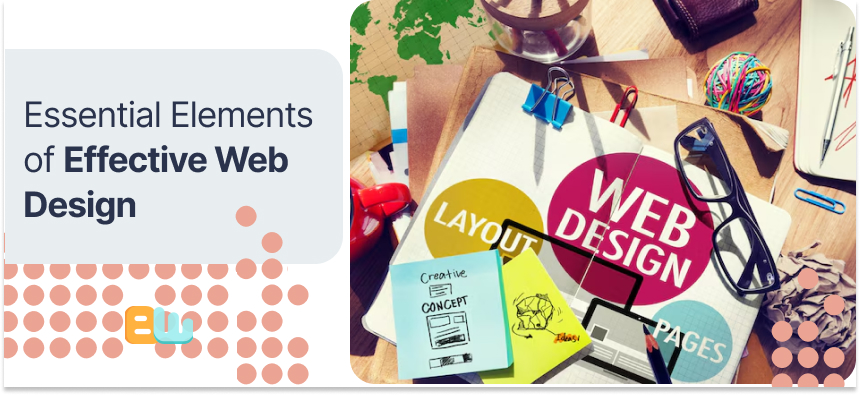
When it comes to making a great website, there are some key things you need to include. First, your site should work well on all devices and screen sizes; this design is responsible. It ensures everyone gets the same good experience no matter how they look at your site. Then, there’s intuitive navigation – they can find their way around your site quickly and get what they need without hassle. And remember technical performance! Having your pages load quickly and using browser caching can make a difference in how smooth and enjoyable someone visits your website.
Responsive Design for Mobile Users
In today’s digital age, more people use their smartphones and tablets to visit websites. With this in mind, it’s super important for your website to look good and work well on all different screen sizes. This is where mobile responsiveness comes into play. Ensuring your site can adjust smoothly from one device to another makes everything easier to read and navigate for everyone checking it out on their mobile devices. This improves the user experience and helps bump up your website in search engine rankings since places like Google value sites optimized for mobile use.
Intuitive Navigation and User Interface
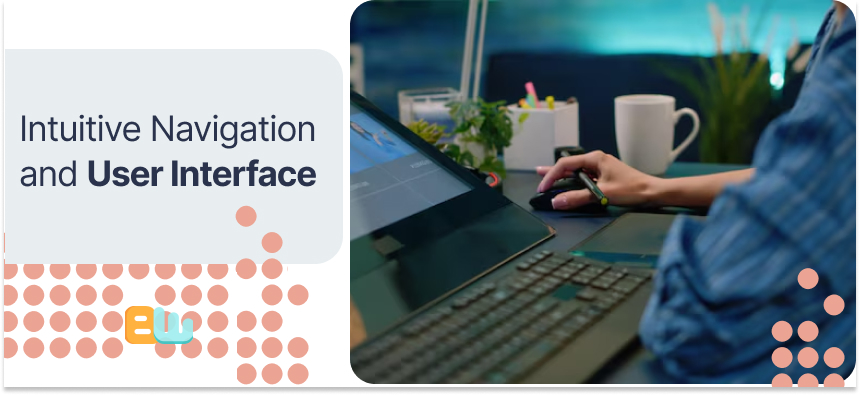
Having a website that’s easy to get around and use is super important if you want it to work well. When your site has a good setup, people can find what they’re looking for without getting lost or frustrated. This means having menus that make sense, pages organized in an easy-to-follow way, and making sure everything on the site is arranged logically. By doing this right, visitors have a better time using your site (which makes them happy), and search engines like Google will also think more highly of your website. They prefer simple sites for everyone to use because those are easier to recommend in search results.
Fast Loading Times and Technical Performance
For a website to do well, it must load quickly and run smoothly. If a site takes too long to load, people get annoyed and might leave, which could be better. To ensure your site is speedy, you can do things like making pictures smaller in size, tidying up the code by getting rid of unnecessary bits and squishing it down, and using something called browser caching. When your website loads fast, not only does everyone visiting have a better time on it (which is super important), but search engines like Google also take notice. They look at how fast websites are when deciding where they should appear in search results; faster sites often end up higher on the list.
Security Considerations in Web Design
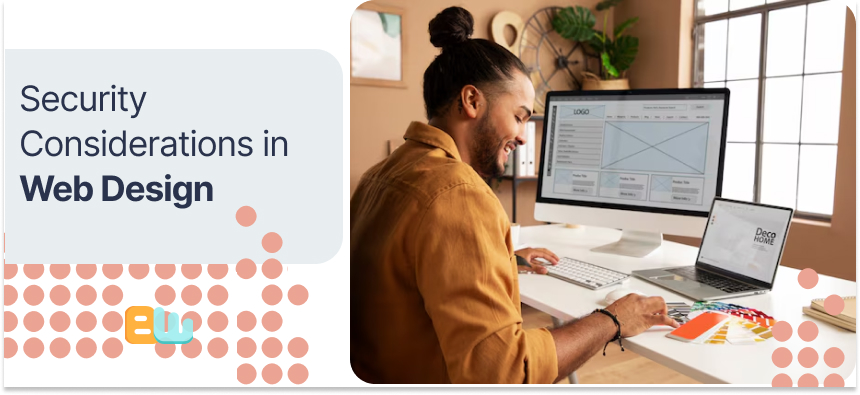
When it comes to web design, keeping things safe is super important. This means making sure that the information people share on a website doesn’t fall into the wrong hands and that everything on the site meets specific rules and laws about privacy. To do this, websites use SSL encryption to keep data safe and secure ways for people to pay online without worrying. By focusing on security in web design, you’re not just looking out for your users by protecting their private info; you’re also boosting your brand by showing you’re trustworthy and reliable.
Protecting User Data and Privacy
In web design, keeping user data and privacy safe is super important. When people give their info to websites, they expect it to stay private and secure. To ensure this happens, web designers must use solid data encryption, systems that make logging in safe, and security checks often. Doing all this helps your website become a place where users feel comfortable sharing information because they trust you’re looking out for them. Plus, it keeps your site away from legal troubles or damage to its reputation by showing you take user safety seriously.
Ensuring Website Compliance and Safety
Ensuring your website is safe and follows the rules is super important for web design. Websites must stick to particular laws like GDPR, which helps keep user information private and secure. To do this right, you have to put things in place, like messages asking for cookie consent, clear privacy policies, and good practices for protecting data. Focusing on keeping your site compliant shows your users that you care about their privacy and safety. This builds trust and makes people see your website as a dependable spot in the digital world.
The Process of Creating an End-to-End Web Design
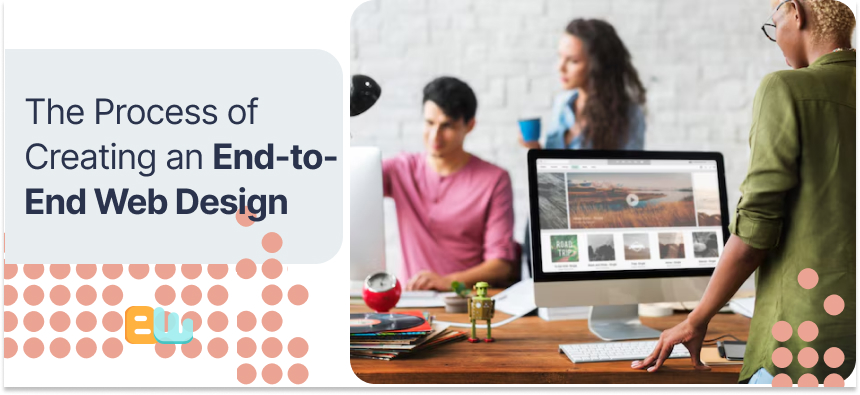
Creating a website from start to finish is like putting together a giant puzzle. It all starts with making a plan and figuring out what the business wants to achieve and who they want to reach. With that in mind, choosing the right colors, fonts, and pictures comes next so everything looks correct and matches what the brand stands for. After that, it’s time to build the site itself, turning those ideas into something tangible that people can interact with easily. Before saying it’s all done, there’s one last step – checking everything carefully to ensure it works perfectly and makes visiting enjoyable for everyone.
Planning and Strategy Development
When it comes to making an excellent website from start to finish, the part where you plan and develop strategies is super important. This step is about figuring out what your business wants to achieve, who you’re trying to reach (your target audience), and what those people are looking for. You also need to dig deep into market research to learn what your competitors are doing and spot any significant trends in your industry. By ensuring that your website matches what your business stands for and appeals directly to your intended audience, you can share what’s unique about your brand more effectively and get more people aware of it. Putting enough thought into planning and strategizing helps ensure that every part of the web design hits the business’s main aims, helping it do well overall.
Design, Development, and Testing Phases
The design, development, and testing phases are essential for the end-to-end web design process. The development team works closely with the business in the design phase to create a visually appealing and user-friendly website. This involves selecting the appropriate design elements, creating wireframes and prototypes, and ensuring a cohesive brand identity. The development phase focuses on implementing the design elements and creating a functional website using programming languages and software development techniques. Finally, thorough testing is conducted to identify and fix any issues or bugs, ensuring the website functions flawlessly. Continuous improvement is an ongoing process, as the website design should evolve and adapt to the business’s and its users’ changing needs.
Conclusion
End-to-End Web Design is super essential for your business to succeed. By taking a full-circle approach to designing websites, you can make a great first impression, get people more involved, and make sure everything works smoothly on any device. Making sure your site is secure and runs fast is critical to building trust and keeping user info safe. A website that responds well is easy to move around in, and loads quickly are all essential to making the user experience top-notch. Always remember that investing money into developing a good web design process means investing in your business’s overall performance.
